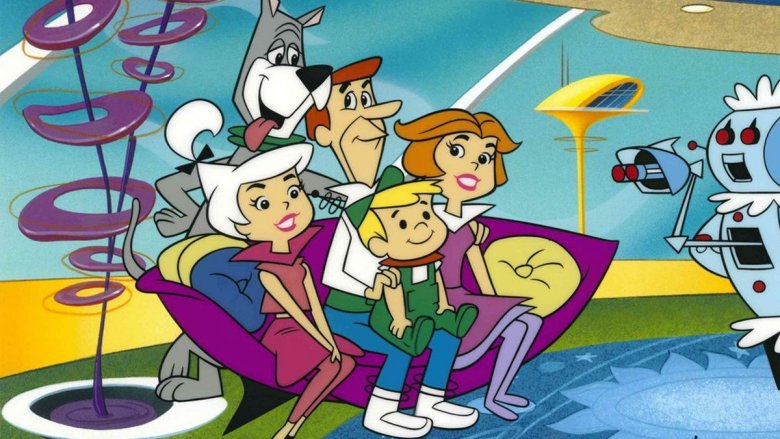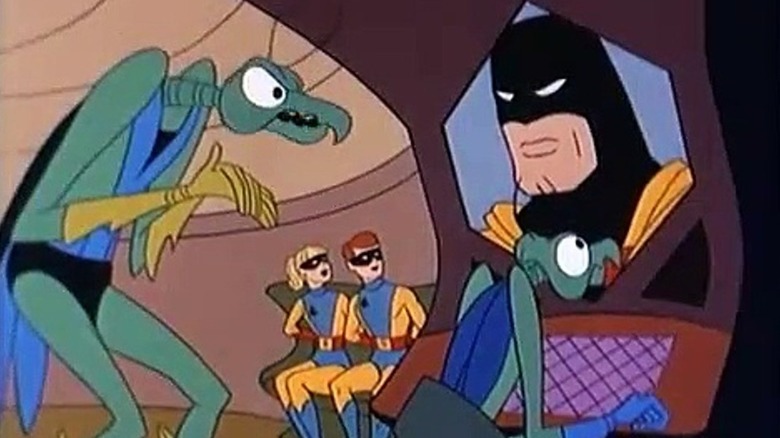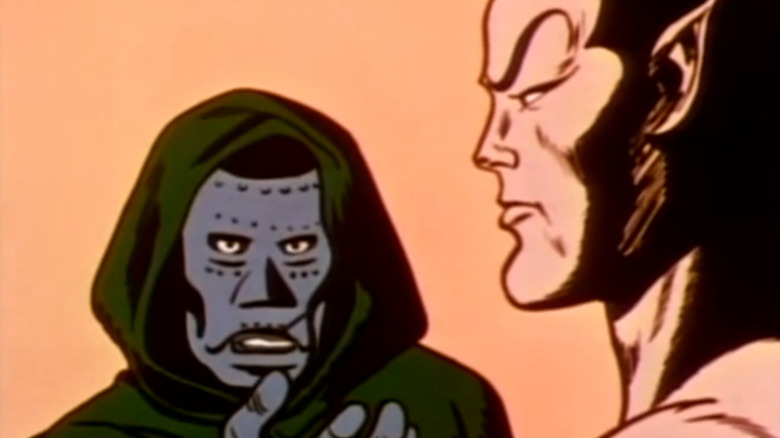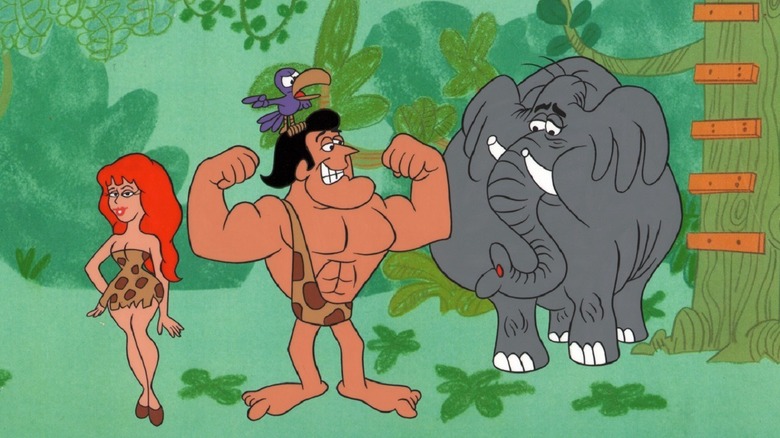Things You Only Notice About '60s Cartoons As An Adult
Television cartoons truly took off in the '60s, thanks mainly to Hanna-Barbera, the studio that made The Flintstones, The Jetsons, Yogi Bear, and a ton of other popular shows. Thanks to cable, home video, and streaming, even people who were born after the '60s have seen many of the cartoons of that decade, or remakes of the same properties. It's when you revisit them as adults, however, that you start to pick up on things that go unnoticed by kids of any era. These are some of the truly weird things only adults will notice about 1960s cartoons.
The Jetsons' future seems like a nightmare to live in
Imagine living in a world where everything happens with the press of a button. Literally everything, from brushing your teeth to making breakfast to putting on your shoes. Imagine having George Jetson's job, to sit at a desk and push a button all day. For that matter, imagine being Jane Jetson—forced to be a homemaker by a mid-20th century version of patriarchy that's survived into the far future, but trapped in a home that makes itself with the push of a button, and a robotic housekeeper to do the rest. It's no wonder she heads out shopping at the beginning of every episode—what else is there to do but retreat into consumerism in a future in which no meaningful work exists? What are Elroy and Judy going to school to learn? How to push buttons? The vision of the future offered by The Jetsons may look shiny and appealing, but the ennui one would feel actually having to live in that world is difficult to contemplate.
Jonny Quest needed better parental supervision
Sure, Jonny Quest is a good kid, and he also manages to hold his own in an adventure and come out on top. Whether facing frogmen in the Sargasso Sea, a reanimated mummy in Egypt, or pirates in the Caribbean, Jonny always does okay, with the help of his best friend Hadji and dog Bandit, under the watchful eye of bodyguard Race Bannon. The real question, however, is why Jonny and Hadji are even there.
Race is meant to have been assigned by the government to protect Jonny, but wouldn't it make more sense to protect Jonny at home in the Quest compound, rather than bringing him and his adoptive brother along on every adventure Dr. Benton Quest gets involved in? If you literally bring your child to where the pirates are, you're only increasing the odds of your child being menaced by pirates. Obviously, if Jonny and Hadji had stayed home, there wouldn't have been a Jonny Quest show, or at least it wouldn't have been as exciting. Still, when you watch it as an adult, especially if you're a parent yourself, it's hard not to question Dr. Quest's choices.
Snagglepuss is obviously gay
You've almost certainly heard this one before, but when you watch the original cartoons, it's every bit as obvious as Saturday Night Live and others have implied. Snagglepuss, the pink mountain lion who had his own segments on The Yogi Bear Show, is deliberately played as a gay stereotype. Many will point out that voice actor Daws Butler is imitating Bert Lahr as the Cowardly Lion in The Wizard of Oz, but Butler's Snagglepuss voice is higher and more feminine than Lahr's ever was—and there's a bit of the gay stereotype in the Cowardly Lion as well, between the presumptive lack of masculinity that goes with being cowardly and the hairbow and curls he wears late in the film. As Vito Russo's book The Celluloid Closet points out, gay references and veiled gay characters go back as far as movies themselves, and existed on television as well. By the time of Snagglepuss' 1961 debut, actor Paul Lynde was already playing such characters on various TV shows. So yes, Snagglepuss is just as gay as he always seemed, and even more so now that he has his own comic book.
Space Ghost is just Batman plus Star Trek
If you were trying to create a popular adventure cartoon in 1966, you could do a lot worse than combining Batman and Star Trek. Batman was already a huge hit on television, but Star Trek and Space Ghost premiered the same month, September 1966, so Trek can't really have been a direct influence. However, the kind of science fiction that Star Trek grew out of was already big in pop culture, thanks to films like Forbidden Planet and Robinson Crusoe on Mars and even the much sillier TV series Lost in Space.
With his imposing black cowl, deadpan line delivery, and tendency to let masked teenagers follow him around, Space Ghost's resemblance to Batman is hard to miss. One of those teenagers, Jace, is a dead ringer for Robin. The other teen, Jan, is a girl wearing the same Robin-esque mask and costume. Her presence makes the group seem more like a small starship crew rather than just a superhero and his subtext-laden sidekick. That's the thing, of course—they are a starship crew. Despite dressing like superheroes and borrowing some tropes and trappings from Batman, Space Ghost takes place in a sci-fi/space opera world, not a superhero world. Instead of a utility belt with smoke bombs and batarangs, Space Ghost wears powerbands that shoot laser beams and a belt that lets him turn invisible, and Jan and Jace are similarly equipped. Even within the sci-fi setting, however, there's a superhero narrative in most episodes, as the trio encounters various outlandish villains during their travels throughout the galaxy and must thwart their evil plans.
Speed Racer is surprisingly violent
Speed Racer was an import from Japan, and it's aged better than a lot of American cartoons from the era. The animation looks great, the character designs are quirky and interesting, and the action is exciting and easy to follow. However, the thing that will shock you on a Speed Racer rewatch is how many people blatantly die. It's hardly ever discussed, but almost every race involves cars going off the road and crashing into rocks or falling off cliffs, often with huge explosions, and no sign whatsoever that the driver escaped. It even happens in the opening sequence! Fight scenes in Speed Racer are also quite violent, particularly when Pops Racer goes into one of his berserker rages. Many episodes also feature villainous gangsters, who never hesitate to just shoot people with machine guns.
Astro Boy is actually quite dark and disturbing
Astro Boy is another Japanese import that doesn't reflect quite what American audiences expect from a cartoon. For one thing, the premiere episode literally begins with a young boy dying in a car crash. His scientist father responds by building a robot version of his dead son, and that's Astro Boy. However, when he realizes that Astro Boy will never grow up like a real child, the scientist rejects him and sells him to a circus. This is the kind of heart-wrenching, quest-for-identity plot you'd expect from a serious live-action movie, not a cute cartoon from 1963. Of course, Astro Boy is soon rescued from the circus by a much friendlier scientist who becomes his father figure and even builds him a robot family, but the character's origin as a failed and rejected replacement for a dead child still hangs over the series.
The Marvel Superheroes Show's animation is both terrible and fascinating
Limited animation was common in the 1960s, especially on television, because it was quicker and cheaper to produce. That's why in so many of these cartoons, nothing but a character's mouth moves when they speak, or they're wearing a stiff collar and only their head moves while their body is totally still. The Marvel Superheroes Show, produced by low-budget studio Grantray-Lawrence Animation, found a new way to do limited animation. Instead of making new drawings of the Marvel characters who appear in the cartoon, they literally took artwork from then-recent Marvel comics and animated parts of them. So on the one hand, the animation itself is pretty terrible, even by 1966 standards. On the other hand, the show is full of art by Jack Kirby, Don Heck, and others, but it moves and talks. So if you're a fan of 1960s Marvel Comics, it's a pretty fascinating thing to see. Sadly, that doesn't mean it's a very good show.
Birdman and the Galaxy Trio looks like a superhero show but really isn't
While Space Ghost mixed superhero tropes with sci-fi adventure, the other classic Hanna-Barbera "superhero" show, Birdman and the Galaxy Trio, barely has any superhero tropes at all. Sure, Birdman is technically a superhero in that he has a superpowers, wears a mask, and his name is Birdman, but he doesn't take his mask off, hide his wings, and go work in an office. He doesn't have a girlfriend from whom he has to hide his superheroic activities. Instead, he seems to live full-time in a volcano base, where his only friends are his falcon Avenger and later his sidekick Birdboy. He doesn't patrol a city to find crimes to stop, he just gets sent on missions by Falcon 7, on behalf of Inter-Nation Security.
The Galaxy Trio are pretty much the same, but in an outer space setting. At first glance they look like a superhero team, but in fact they're just one division of an interstellar law enforcement agency known as the Galactic Patrol. They don't even necessarily have superpowers, just alien abilities that humans lack. Like Birdman, they take their missions from a commanding officer, who they call chief. Birdman may not be much of a superhero, but the Galaxy Trio aren't superheroes at all—they're cops.
Secret Squirrel is full of references to grownup movies
Plenty of Hanna-Barbera cartoons have celebrity references, often in the voices and mannerisms of the characters. Yogi Bear is Art Carney, Doggy Daddy is Jimmy Durante, Top Cat is Phil Silvers, and so on. 1965's Secret Squirrel, however, took things to another level. The show is a light, kid-friendly parody of the James Bond films, with Secret Squirrel as Agent 000 of the Sneaky Service, taking his orders from Double-Q. Weirdly, however, there's also a film noir, Maltese Falcon aspect, with Secret Squirrel's sidekick Morocco Mole talking like Peter Lorre. The main antagonist, Yellow Pinkie, is obviously inspired by the titular villain from the 1964 Bond film Goldfinger, but he also resembles Kasper Gutman, the villain played by Sydney Greenstreet in The Maltese Falcon. The actual plots and animation from Secret Squirrel are generally pretty uninspired, so it's possible all these movie references were simply the result of its creators trying to keep themselves entertained, but it's definitely the most interesting aspect of the show.
George of the Jungle is actually great
Depending on when you grew up, you may remember George of the Jungle as a song on "Weird Al" Yankovic's album Dare to Be Stupid (the only non-parody cover song Weird Al ever recorded), a 1997 movie starring Brendan Fraser, or any of several cartoons that have existed over the years. You may find yourself wondering why so much media has revolved around a silly animated show from the '60s, but if you revisit the original 1967 cartoon, you'll discover it's actually one of the best-made cartoons of the decade.
George of the Jungle was created and produced by Jay Ward and Bill Scott, creators of Rocky and Bullwinkle. Like that cartoon, it features surprisingly grownup and clever jokes. Whereas Rocky and Bullwinkle was cheaply animated in Mexico, however, George of the Jungle was animated in Los Angeles by veterans who knew what they were doing, and it shows. The character designs are simple, but appealing and recognizable, and they move with a fluidity almost unheard of in American TV animation of the 1960s. In fact, the only reason the show was short-lived was because Jay Ward was so happy with the high-quality animation that he let the show go over budget. Inevitably much of the humor in George of the Jungle is dated five decades later, and in particular a lot of the white-protagonist-in-Africa tropes don't look so good by modern standards, but if you're interested in animation of the 1960s, this is the show to revisit. Also, that theme song really is great.



